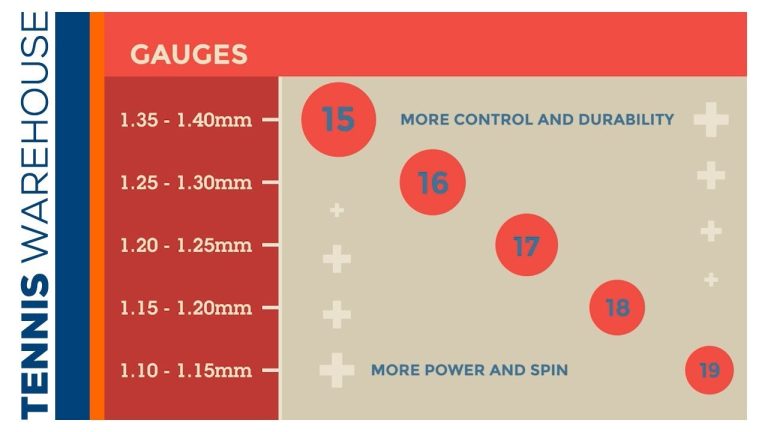Are you looking to enhance your tennis game? One important factor to consider is the string gauge of your racket. The string gauge refers to the thickness of the strings used in your racket. A thinner gauge provides more power and spin, while a thicker gauge offers durability and control. Choosing the right string gauge can greatly impact your performance on the court. In this article, we will explore the various string gauges available and help you make an informed decision to take your tennis game to the next level.
What gauge string should I use, 16 or 17?
When deciding between 16 or 17 gauge string, it is important to consider your skill level and playing style. If you are a competitive player seeking a balance between power and control, the 16L/1.28mm gauge string is your best choice. This medium gauge, commonly found in Luxilon strings, provides the optimal blend of power and control, allowing you to deliver powerful shots while maintaining accuracy on the court.
On the other hand, if you are a beginner or intermediate player looking for power and comfort, the 17/1.25mm gauge string is the ideal option. This medium thin gauge is designed to enhance power and provide a comfortable feel during play. It is perfect for players who are still developing their skills and want to focus on generating power and enjoying a comfortable playing experience. Ultimately, the decision between 16 and 17 gauge string depends on your individual needs and preferences on the court.
What differentiates 1.25 strings from 1.30 strings?
The difference between 1.25 and 1.30 strings lies in the gauge of the string. When it comes to monofilament string, the intermediate gauge measures 1.25mm. On the other hand, for multifilament string, the intermediate gauge measures 1.30mm. This distinction in gauges determines whether the string is considered thin or thick, catering to different playing styles and preferences.
What is the relationship between thicker strings and the ability to hold tension in tennis?
Thicker strings may hold tension better in tennis, particularly when using thicker mains than crosses. While thicker mains can provide increased tension maintenance, they also lead to decreased tension maintenance of the cross strings. On the other hand, opting for thinner crosses can offer a softer feel, enhanced power, and improved spin. Thicker crosses, however, generate more friction on the mains, limiting string movement and consequently reducing spin.
By utilizing thicker mains than crosses, tennis players can potentially enhance tension maintenance in their strings. Nevertheless, this approach also results in decreased tension maintenance for the cross strings. Alternatively, opting for thinner crosses can provide players with a softer sensation during play, while also amplifying power and facilitating spin. Conversely, choosing thicker crosses can lead to increased friction on the mains, minimizing string movement and ultimately diminishing spin.
Unraveling the Mystery: Decoding Tennis Racket String Gauges
Unraveling the Mystery: Decoding Tennis Racket String Gauges
Choosing the right string gauge for your tennis racket can make a world of difference in your game. From power to control, the string gauge plays a crucial role in determining the overall performance of your racket. A thinner string gauge, such as 16 or 17, offers more control and allows for precise shots, making it ideal for advanced players. On the other hand, a thicker string gauge, like 15 or 14, provides more power and durability, making it a popular choice among beginners or players with a powerful swing. Understanding the different string gauges and their impact on your game is key to unlocking your true potential on the court.
When it comes to string gauges, the choices can be overwhelming. However, by decoding the mystery behind these numbers, you can make an informed decision that complements your playing style. String gauges are measured in increments of 0.5, with a higher number indicating a thinner string. The thinner the string gauge, the more control you have over your shots, allowing you to maneuver the ball with precision. Conversely, a thicker string gauge provides more power and durability, making it suitable for players who rely on their strength to deliver powerful shots. By understanding the science behind tennis racket string gauges, you can fine-tune your game and enhance your performance on the court.
Mastering the Game: Unlocking the Power of the Right Tennis Racket String Gauge
Mastering the Game: Unlocking the Power of the Right Tennis Racket String Gauge
Choosing the right tennis racket string gauge can make all the difference in your game. With a thinner gauge, you gain more control and feel, allowing for precise shots and improved spin. On the other hand, a thicker gauge provides added durability and power, perfect for players with a more aggressive playing style. By understanding the impact of string gauge on your game, you can unlock the true potential of your tennis racket and take your skills to the next level. So, whether you’re a finesse player or a power hitter, finding the perfect string gauge will help you master the game and dominate the court.
In the world of tennis, the choice of string gauge for your racket can make all the difference in your performance on the court. Whether you prefer power, control, or a balance of both, selecting the right string gauge is crucial. By considering factors such as your playing style, skill level, and personal preferences, you can find the perfect string gauge that enhances your game and helps you dominate the competition. So, next time you step onto the court, make sure you have the optimal string gauge on your racket and get ready to unleash your full potential.
